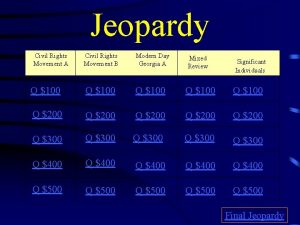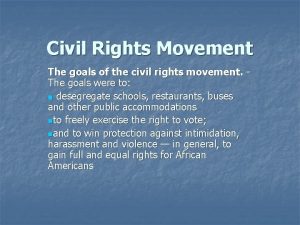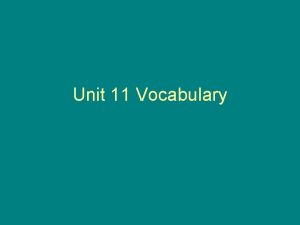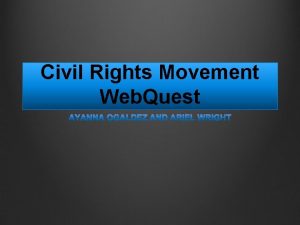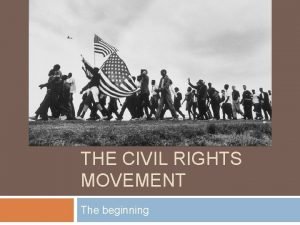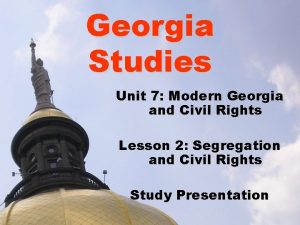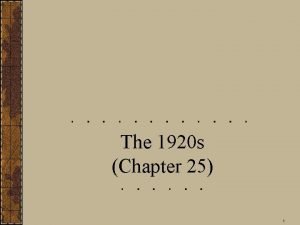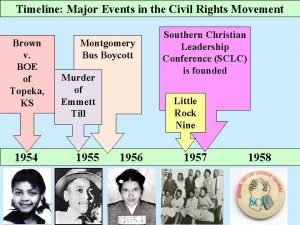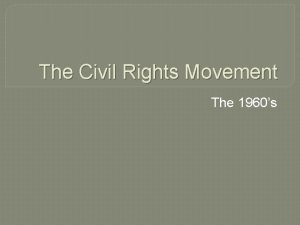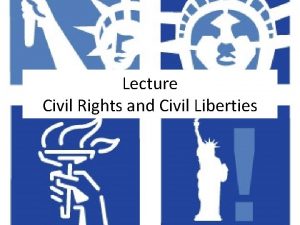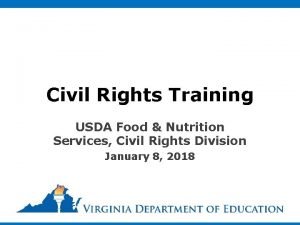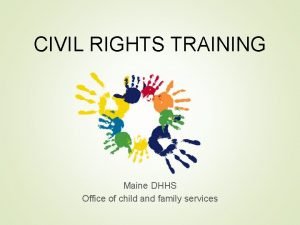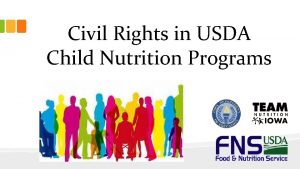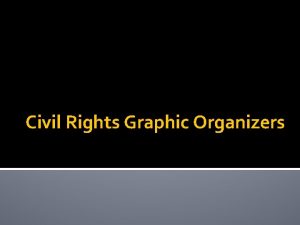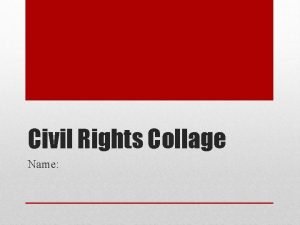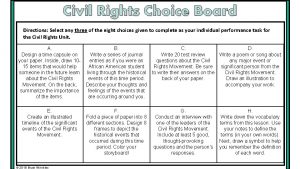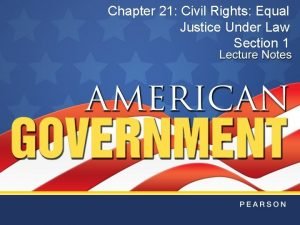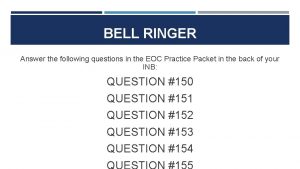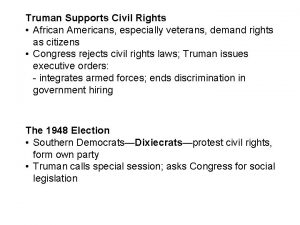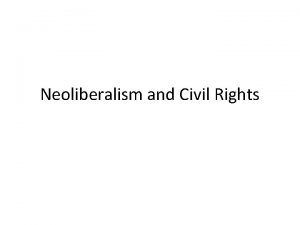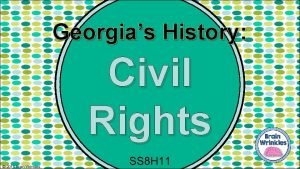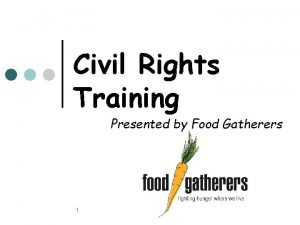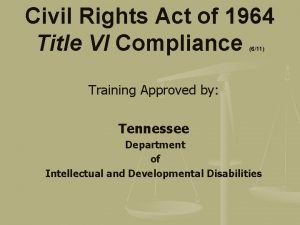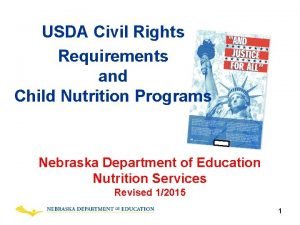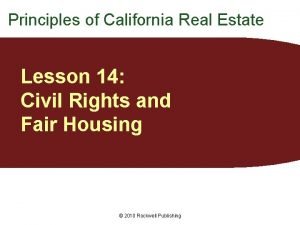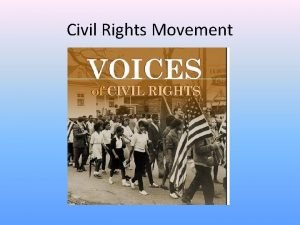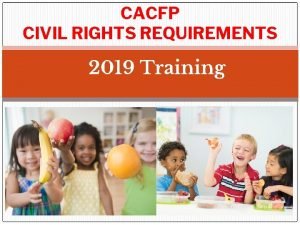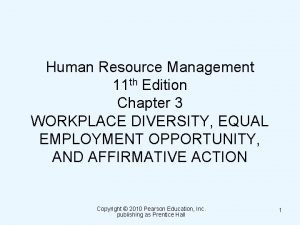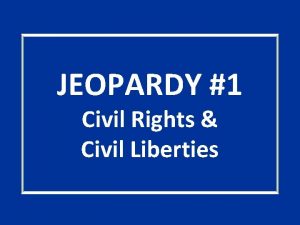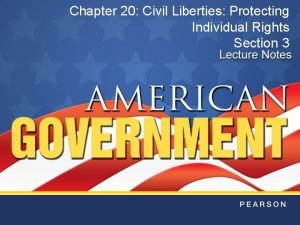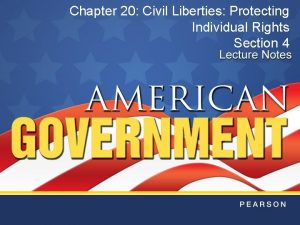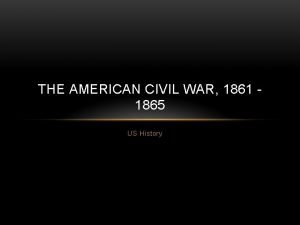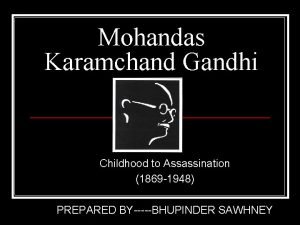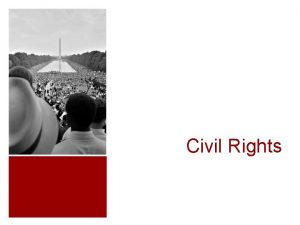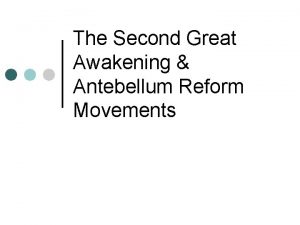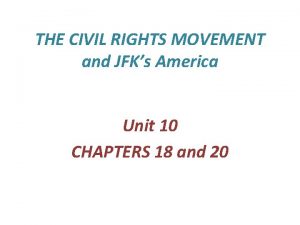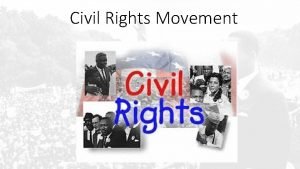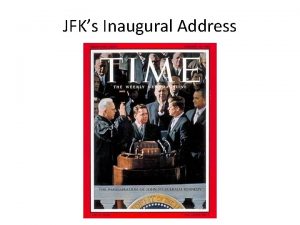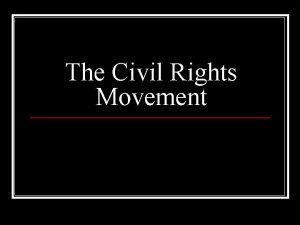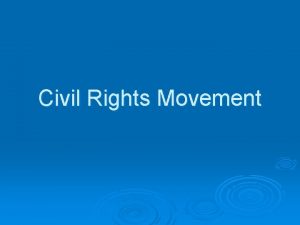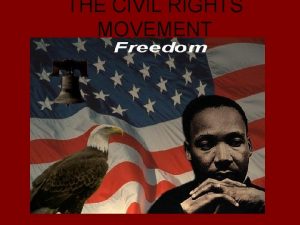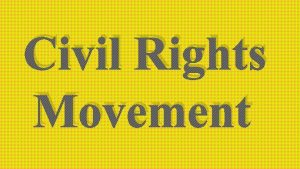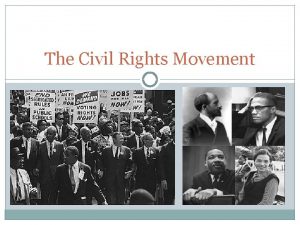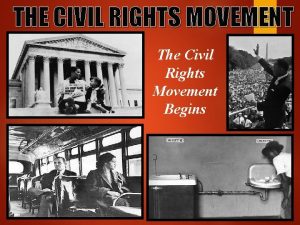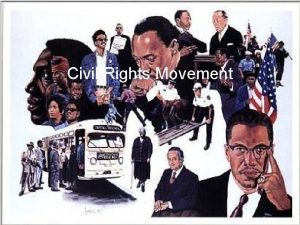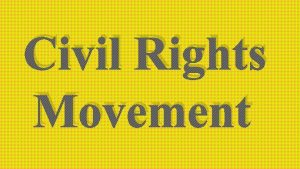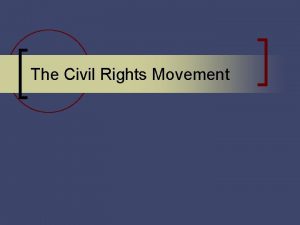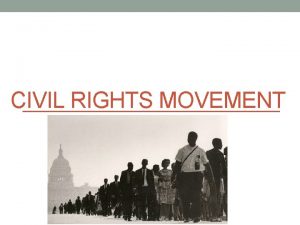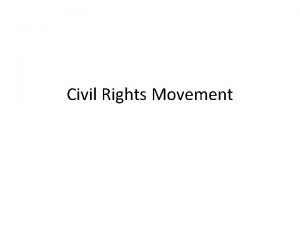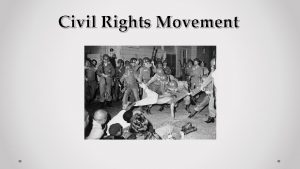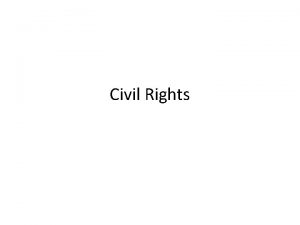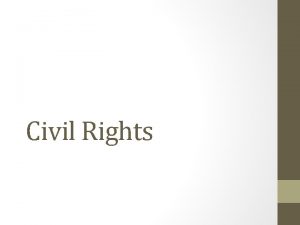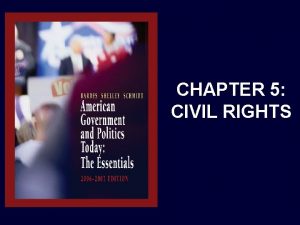THE CIVIL RIGHTS MOVEMENT and JFKs America Unit



















































- Slides: 51

THE CIVIL RIGHTS MOVEMENT and JFK’s America Unit 10 CHAPTERS 18 and 20 Motivation for the Civil Rights movement-Jim Crow laws & voting restrictions indicated that individual rights were not upheld

NB 99 Carl Sandburg’s poem "Choose. " Choose BY CARL SANDBURG THE single clenched fist lifted and ready, Or the open asking hand held out and waiting. Choose: For we meet by one or the other. 1. 2. 3. 4. What is Sandburg say about conflict and how it can be solved? Where do you see violence? Nonviolent behavior? Silently think how about how you solve conflicts. Why do some conflicts lead to violence but others solved peacefully?

Reflect on Martin Luther King’s Dream, 1963 Briefly write about a personal experience you have had with violence or nonviolence. • What fears did you have when put in this situation? • Looking back on the experience, would you have acted differently? Why or why not? • Throughout this lesson I want you to record the types of conflicts- non violent v violent-that MLK encountered in his life.

Use this video to: 1. How does Common’s lyrics approach conflict? 2. Cite examples of nonviolence from the video. 3. Compare Common’s dream with Martin Luther King’s dream. How are they similar? 4. How does Common use nonviolence to achieve his dream? 5. What are the similarities between Martin Luther King’s and Common’s view of nonviolence?


Is it possible for nonviolent direct action to transform a community? 1. Receive either a copy of “The Six Principles of Nonviolence” and “Six Steps of Nonviolent Direct Action. ” 2. Why do you think MLK wrote the “The Six Principles of Nonviolence”? 3. Why do you think MLK wrote the “Six Steps of Nonviolent Direct Action”? 4. Why do you think people you participate in direct action needed to be educated in nonviolence? NOTE: You will connect your learning in the unit to the six principles/six steps as you learn the story of the US Civil Rights Movement

Beginning of the Civil Rights Movement • Civil rights- citizen’s legal rights; government protected. • Civil Rights Movement- Work to obtain equal legal rights for all races. • How it started: 1. World War II-Double Victory 2. Harry Truman -desegregated military

Beginning of the Civil Rights Movement • Desegregation: – Brown v. Board of Education-1954 NAACP argued to integrate schools. Supreme Court ruled segregation unconstitutional (integration public schools) Overturned Plessey v. Ferguson 1898 – 1890 s Plessy v. Ferguson Was overturned by the Supreme Court in 1954 with Brown v Board as it violated the 14 th amendment equal protection clause. – 1954 Constitution is a living document Brown v. Board of Education overturned a previous Supreme Court ruling. Plessy (1890 s)

• Desegregation was S—L—O—W. So U. S. Supreme Court Issued Brown II ruling requiring desegregation “with all deliberate speed” • Little Rock Nine & President Eisenhower – Resistance to Supreme Court Ruling – 1957 Central HS, Little Rock, Arkansas. NAACP had 9 black students (Little Rock Nine) attempt to integrate. – Arkansas Governor Orval Faubus ordered troops to prevent from them from entering – Pres. Eisenhower ordered the natl. guard to protect the nine as they attended class.

• Civil Rights Act of 1957 - the federal government enforces civil rights

1. What do you see happening here? 2. What is a “normal” reaction? 3. What principles of non-violence do you see here? 11

Violence & Southern Resistance – Southern segregationist private schools opened. – KKK resurged/lynching increased. – Emmett Till- 14 yr. old African-American boy murdered in 1955 for allegedly whistling at a white woman

1. What do you see happening here? 2. What is a “normal” reaction? 3. What principles of non -violence do you see here?

Civil Rights Movement Grows Montgomery, Alabama 1955 • Rosa Parks she refused to sit in segregated Montgomery City bus. Arrested. • Martin Luther King Jr. , emerging civil rights leader, responded organizing the Montgomery Bus Boycott. (1955) where people refused to ride the bus. Civil disobedience. Rosa Parks

Civil Rights Movement Grows Rosa Parks


• Different civil rights groups existed because African-American worked in different methods to gain equality: – NAACP- National Association for the Advancement of Colored People (fought for equality in the courts) – SCLC- Southern Christian Leadership Conference (nonviolence) – SNCC- Student Nonviolent Coordinating Committee (thought change was too slow) – CORE- Congress of Racial Equality (sit-ins)

The 1960 s protest events like sit-ins, bus boycotts, enrolling in schools, and freedom rides were aimed at winning the battle for integration through MLK’s non-violent methods. 1. What do you see happening here? 2. What is a “normal” reaction? 3. What principles of non-violence do you see here?

1960 Presidential Election • D: John F. Kennedy beat Republican V. P. Richard Nixon • 1 st T. V. debate • Youngest president • 1 st Catholic

1960 Presidential Election

JFK’s Domestic Plan: THE NEW FRONTIER New Frontier-: Kennedy promised progress. Called for to strengthen: • International aid-Peace Corps- volunteer help to developing nations. • Alliance for Progress- help Latin America; prevent communism

JFK’s Domestic Plan: THE NEW FRONTIER New Frontier-: Kennedy promised progress. Called for to strengthen: • Space program-NASA created; goal man on moon; science & math • Education • Elderly • Urban poor-JFK called for an assault on the causes of poverty. U. S. Atty Gen, Robert Kennedy, investigate racial injustices.

1961 Freedom Rides Bus trips to test the Supreme Court desegregation ruling on interstate bus routes and facilities. Met with great violence, but it forced the federal government to protect the riders.

1961 Freedom Rides

1. What do you see happening here? 2. What is a “normal reaction? 3. What principles of nonviolence do you see here?

1962 James Meredith & Ole Miss • He won a federal court case to enroll at white Ole Miss • Governor Ross Barnett refused. Kennedy ordered federal marshals to escort Meredith. Gov. Barnett vowed to never surrender to integration. Riots erupted. 200 arrested. Two killed. Meredith enrolled.

1. What do you see happening here? 2. What principles of nonviolence do you see here?

1963 The March on Washington • Dr. King organized 1963 integrated march to Washington D. C. • 250, 000 attended to show support the Civil Rights Act 1964 which outlawed discrimination.

1. What do you see happening here? 2. What principles of non-violence do you see here?

1963 JFK Assassinated • Accused gunman was Lee Harvey Oswald who was killed by Jack Ruby • 1963 Warren Commission-Investigated the assassination of John F. Kennedy • VP Lyndon B. Johnson became President. • He continued JFK’s ideas

Jackson assassination of Civil Rights Activist Medgar Evers • June 1963 Mississippian, veteran and civil rights activist and state field secretary of the NAACP, Medgar Evers, shot by Bryan de la Beckwith. • This spurred Dr. Martin Luther King

The Civil Rights Act of 1964 Congress passed & President Lyndon Johnson signed the Civil Rights Act of 1964. This law: • Desegregated all public facilities • Established the Equal Employment Opportunity Commission • Gave federal government power to pursue Civil Rights violations

The Civil Rights Act of 1964 • 1964 Civil Rights Act-intended to end discrimination based on race or gender. • However, voting was still issue in South. Literacy tests and poll taxes were still being used to prevent them from voting.

SNCC & CORE Freedom Summer 1964 • Registered southern African-Americans to vote. • Three civil rights workers murdered in Neshoba County. • That summer, two white civil rights workers and one black worker were killed in Philadelphia, MS. • This atrocious crime spurred Congress and President Johnson to pass the Voting Rights Act of 1965

Voting Rights Act 1965 - ended • literacy tests • feds monitored voter registration • 24 th Amendmentabolished the poll tax 1964 Impact of Freedom Summer-Efforts to encourage African American voter registration was successful as many more registered to vote.

Fannie Lou Hamer Later that year, Fannie Lou Hamer an African-American Mississippi woman gave a speech at the Democratic National Convention promoting Civil Rights, especially voting rights.

Protest Marches: Nonviolent Awareness Tactic

The Civil Rights Act of 1964 • 1964 Selma to Montgomery voting rights marches. Aided the movement by rallying support among national politicians

Protest Marches: Nonviolent Awareness Tactic • Selma Campaign - march from Selma to Montgomery for voting rights; whites became violent 1964

Protest Marches: Nonviolent Awareness Tactic • 1965 LBJ's Voting Rights Act-Legislation removed unfair electoral requirements; increase voters African. American elected. • 1965 Federal government responds to CRM-Actively secured constitutional guarantees sending troops to integrate in 1957 passing Civil Rights Act of 1964 and Voting Rights Act of 1965

Black Power- call for blacks to lead their own organizations. • Other groups did not feel like change was happening fast enough. • The Nation of Islam- headed by Elijah Muhammad called for violent action to promote social change immediately • Malcolm X- began as a radical separatist but later did a 180 and preached mutual love. Killed by a radical Muslim in 1965. • Black Panthers- California. Fight social injustices and often used violence and intimidation. Won support in impoverished areas and created many helpful programs too.

Black Power. Stokely Carmichael-He was dissatisfied with civil disobedience. Embraced violence, "We shall overrun!" 1969 Black Panthers-Used militant tactics; did not consider Dr. King's tactics effective.

1968 MLK assassinated in Memphis • 1968. MLK was assassinated in Memphis by James Earl Ray. His death slowed the civil rights movement. • 1968 Martin Luther King Jr. & Robert Kennedy. Assassinated in 1968 – Affirmative action- program with preferential treatment to minority groups – 1970 s affirmative action designed to encourage equal employment opportunities for women and minorities.

Hispanic Civil Rights Movement • Latino Americans (Hispanics) learned protest methods from African Americans; they worked for rights • Cesar Chavez- Leader. Founded United Farm Workers unionfought for of Hispanic working rights of agricultural laborers. • They created awareness promoting work stoppages (strikes) and boycott.

Hispanic Civil Rights Movement • Jose Angel Gutierrez founded the Hispanic political party, La Raza Unida- which gained support in California • Hispanics promoted education bilingualism-teaching • 1968 Bilingual Education Act- Expanded access to public education to immigrants speaking their native language. • 1980 s- States passed laws making English the official language.

Women’s Civil Rights Movement • Just like African Americans women wanted economic opportunity in their Civil Rights movements. Learned from Civil Rights methods. • Betty Friedan’s book, The Feminine Mystique (1963) Raised awareness. Women wanted to be more than wives and mothers. • feminism- belief that women should have equality with men. • National Organization for Women (NOW)- pushed for women’s equal rights and opportunity with an amendment. • Equal Rights Amendment Congress passed but states refused to ratify. Failed. Would have ended legal distinction in gender in divorce, property, and employment.

Women’s Civil Rights Movement • 1973 Roe v. Wade-US Supreme Court ruled that women could choose abortion during early pregnancy. • Title IV of the Civil Rights Act of 1964 - law requires that for every male sport in school, a female sport is required; equal opportunity. • Lasting impact of African-American civil rights movement: Brought about anti-discrimination legislation that applied to other groups like women and Hispanics.

Native American’s Civil Rights Movement – AIM (American Indian Movement) was formed to be a self -defense group against police brutality, but became a militant advocacy group. – Some problems that AIM sought to deal with: • High infant mortality rates (2 x the national average) • Low life expectancy • High unemployment • High alcoholism rates • High rates of tuberculosis • High rates of poverty

Native American’s Civil Rights Movement • 1970 s American Indian Movement-Used more militant tactics than Dr. Martin Luther King Jr. as they did not consider Dr. King's tactics were not as effective in achieving goals • AIM preserved the traditional culture of Native American Indians

Native American’s Civil Rights Movement • • In 1973, AIM held a protest at Wounded Knee, SD. They took hostages, and a shoot-out with the FBI 2 AIM members dead Government to re-examine treaty rights. New laws passed to help achieve AIM goals.

Disabled Civil Rights Movement • Disability rights groups learned from the African American CRM. • Organized and protested for government actions. They used sitins to achieve their goals. • Section 504 of the Rehabilitation Act of 1973 outlawed discrimination against the disabled encouraging equal treatment of all Americans • Difficult to enforce. • 1990 Americans with Disabilities Act- Expanded equal opportunities for people with disabilities allowing access for all disabled persons to all public facilities.
 Civil rights webquest
Civil rights webquest Rosa parks mother
Rosa parks mother Civil rights movement jeopardy
Civil rights movement jeopardy Civil rights movement goal
Civil rights movement goal Civil rights movement vocabulary
Civil rights movement vocabulary Civil rights movement webquest
Civil rights movement webquest The civil rights movement
The civil rights movement Civil rights movement essential questions
Civil rights movement essential questions Unit 7: modern ga and civil rights
Unit 7: modern ga and civil rights La raza apush
La raza apush Chapter 14 postwar prosperity and civil rights
Chapter 14 postwar prosperity and civil rights Positive vs negative rights
Positive vs negative rights Duty towards self
Duty towards self Legal rights and moral rights
Legal rights and moral rights Positive rights and negative rights
Positive rights and negative rights Civil rights timeline of events
Civil rights timeline of events Civil rights sitins
Civil rights sitins Right to die
Right to die Usda civil rights training
Usda civil rights training Civil rights training child nutrition programs
Civil rights training child nutrition programs Civil rights in child nutrition programs
Civil rights in child nutrition programs Civil rights graphic organizer
Civil rights graphic organizer Civil rights collage
Civil rights collage Civil rights choice board
Civil rights choice board Chapter 21 civil rights equal justice under law
Chapter 21 civil rights equal justice under law Chapter 20 civil liberties protecting individual rights
Chapter 20 civil liberties protecting individual rights Civil rights bell ringers
Civil rights bell ringers Truman supports civil rights
Truman supports civil rights Characteristics of civil rights
Characteristics of civil rights Civil rights cloze notes 1
Civil rights cloze notes 1 Civil rights cloze notes 1
Civil rights cloze notes 1 Federally protected classes
Federally protected classes Title vi of the civil rights act of 1964
Title vi of the civil rights act of 1964 Civil rights in child nutrition programs
Civil rights in child nutrition programs Unruh civil rights act real estate
Unruh civil rights act real estate Civil rights movment
Civil rights movment Cacfp civil rights
Cacfp civil rights Title vii of the civil rights act
Title vii of the civil rights act Title vii of the civil rights act
Title vii of the civil rights act Civil rights jeopardy
Civil rights jeopardy What did sncc accomplish and how
What did sncc accomplish and how Chapter 20 civil liberties protecting individual rights
Chapter 20 civil liberties protecting individual rights Chapter 20 civil liberties protecting individual rights
Chapter 20 civil liberties protecting individual rights America civil war
America civil war Difference between riparian and littoral rights
Difference between riparian and littoral rights Negative rights
Negative rights Negative rights
Negative rights Negative rights vs positive rights
Negative rights vs positive rights Program of civil disobedience movement
Program of civil disobedience movement Civil right movement def
Civil right movement def What is a non movement area
What is a non movement area Women's rights movement
Women's rights movement


